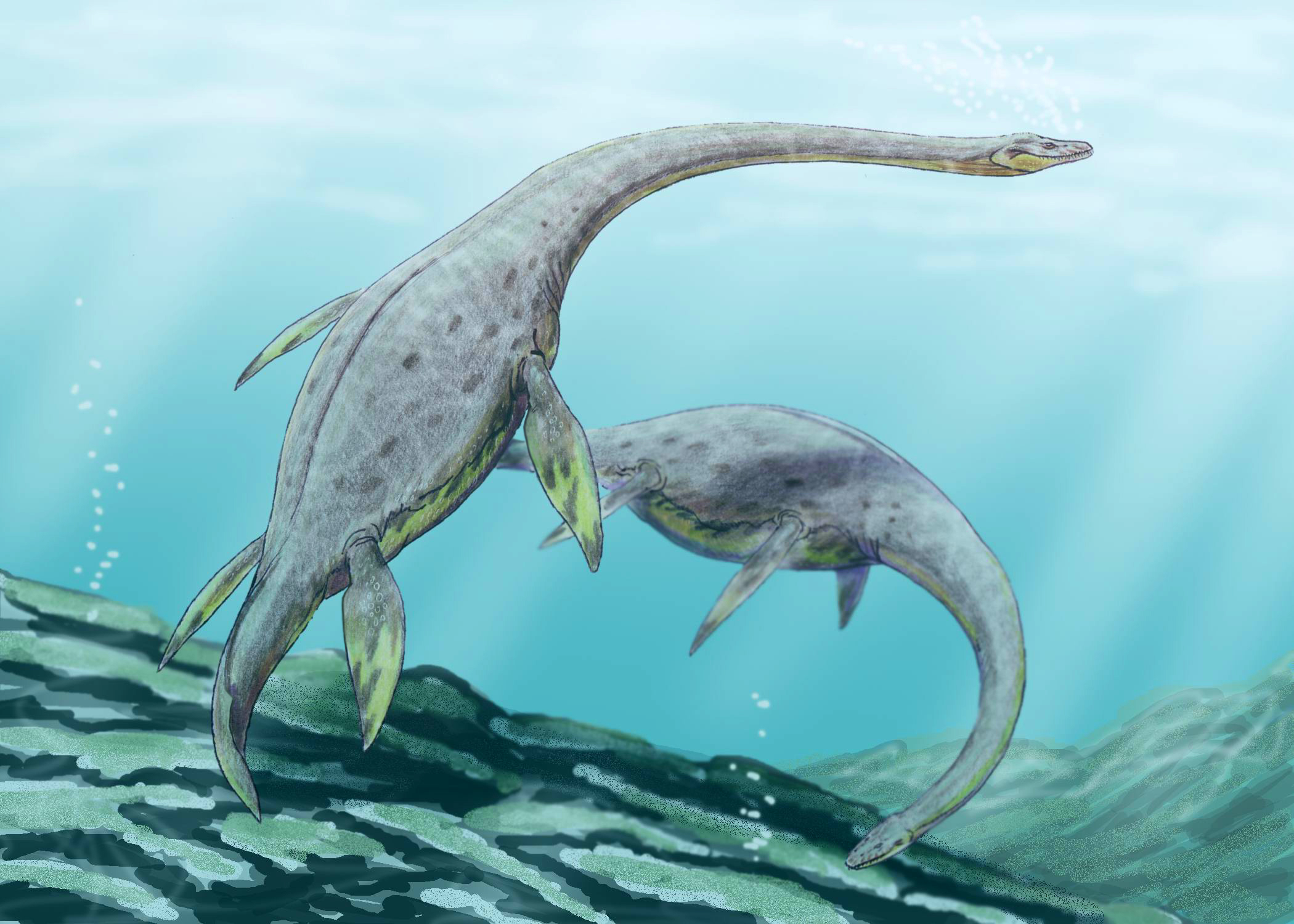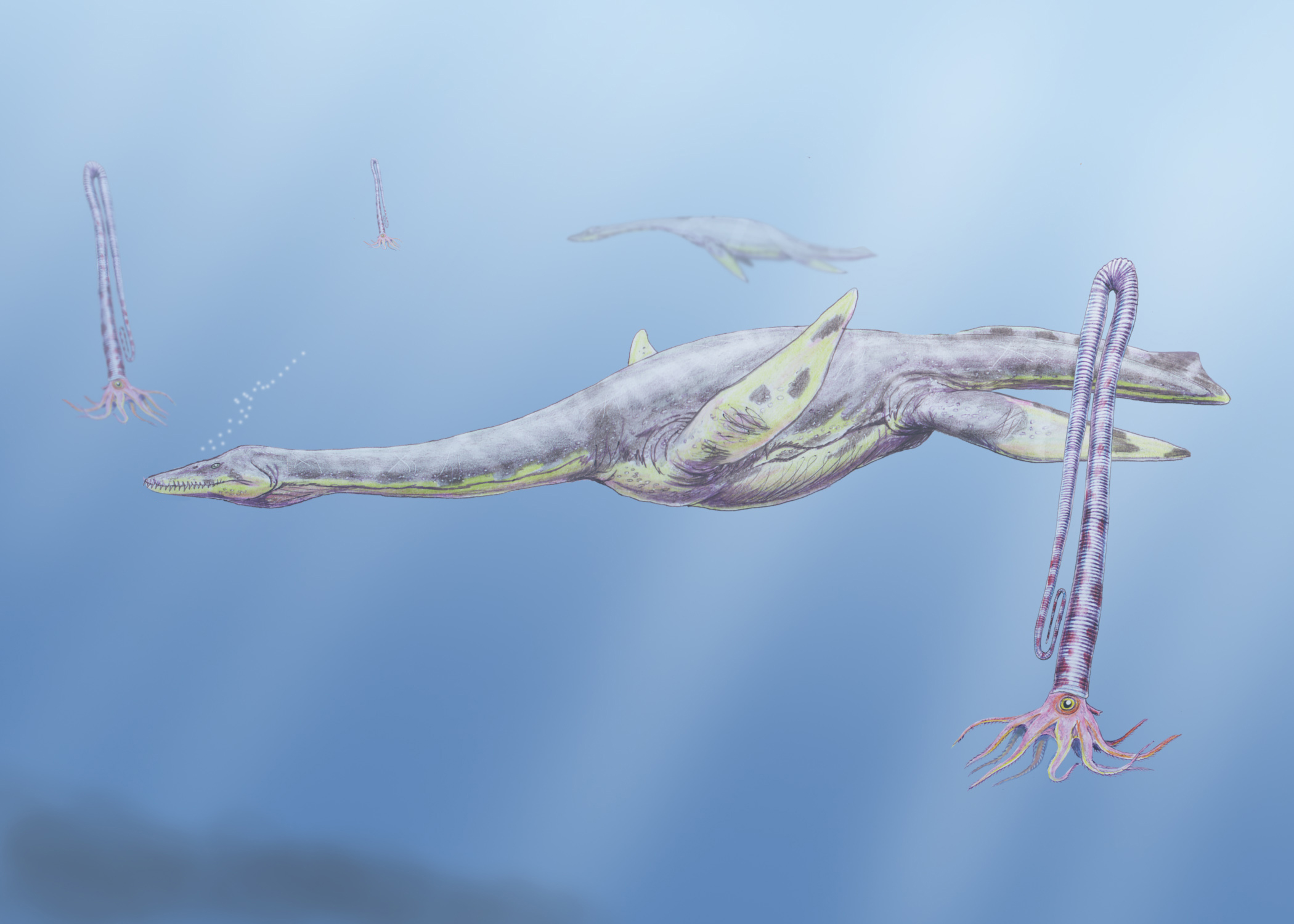|
Pantosaurus
''Pantosaurus'' ("all lizard") is an extinct genus of plesiosaur from the Late Jurassic ( Oxfordian) of what is now Wyoming. It lived in what used to be the Sundance Sea. It was originally named ''Parasaurus'' ("near lizard") by Othniel Charles Marsh in reference to ''Plesiosaurus'', but that name was preoccupied, and Marsh changed it. The species ''Muraenosaurus reedii'' is in fact a junior synonym of ''Pantosaurus''. The holotype YPM 543 is a partial articulated skeleton, partially prepared to yield a distal humerus, four articulated carpals, a fragment of the coracoid, and several isolated cervical vertebrae from the Upper Member of the Sundance Formation. Other material includes USNM 536963, USNM 536965, UW 3, UW 5544 and UW 15938. Palaeobiology ''Pantosaurus'' possesses between 35 and 40 cervical vertebrae, which are very similar in proportion and morphology to those of '' Muraenosaurus leedsii'' from the Oxford Clay Formation (Callovian, Middle Jurassic) of England. The ... [...More Info...] [...Related Items...] OR: [Wikipedia] [Google] [Baidu] |
Plesiosaur
The Plesiosauria (; Greek: πλησίος, ''plesios'', meaning "near to" and ''sauros'', meaning "lizard") or plesiosaurs are an order or clade of extinct Mesozoic marine reptiles, belonging to the Sauropterygia. Plesiosaurs first appeared in the latest Triassic Period, possibly in the Rhaetian stage, about 203 million years ago. They became especially common during the Jurassic Period, thriving until their disappearance due to the Cretaceous–Paleogene extinction event at the end of the Cretaceous Period, about 66 million years ago. They had a worldwide oceanic distribution, and some species at least partly inhabited freshwater environments. Plesiosaurs were among the first fossil reptiles discovered. In the beginning of the nineteenth century, scientists realised how distinctive their build was and they were named as a separate order in 1835. The first plesiosaurian genus, the eponymous '' Plesiosaurus'', was named in 1821. Since then, more than a hundred ... [...More Info...] [...Related Items...] OR: [Wikipedia] [Google] [Baidu] |
Sundance Formation
The Sundance Formation is a western North American sequence of Middle Jurassic to Upper Jurassic age Dating from the Bathonian to the Oxfordian, around 168-157 Ma, It is up to 100 metres thick and consists of marine shale, sandy shale, sandstone, and limestone deposited in the Sundance Sea, an inland sea that covered large parts of western North America during the Middle and early Late Jurassic. Geology The Sundance Formation underlies the western North American Morrison Formation, the most fertile source of dinosaur fossils in the Americas, and is separated by a disconformity from the underlying Middle Jurassic Gypsum Springs Formation. Fossils The Sundance Formation is known for fossils of an extinct species of marine cephalopod, the belemnite '' Pachyteuthis densus'', as well as several extinct species of oyster, including ''Deltoideum'', ''Liostrea'', and ''Gryphaea nebrascensis''. Fossil dinosaur 'footprints' on an ancient ocean shoreline are preserved in the formation and ... [...More Info...] [...Related Items...] OR: [Wikipedia] [Google] [Baidu] |
Muraenosaurus
''Muraenosaurus'' (from the Latin "''Muraena''" meaning "eel" and "''Sauros''" meaning lizard) is an extinct genus of cryptoclidid plesiosaur reptile from the Oxford Clay of Southern England. The genus was given its name due to the eel-like appearance of the long neck and small head. ''Muraenosaurus'' grew up to in length and lived roughly between 160 Ma (million years ago) and 164 Ma in the Callovian of the middle Jurassic. Charles E. Leeds collected the first ''Muraenosaurus'' which was then described by H. G. Seeley.Seeley, HG. 1874. On ''Murænosaurus Leedsii'', a Plesiosaurian from the Oxford Clay. Part I. ''Quarterly Journal of the Geological Society'' 30: 197-208. The specimen may have suffered some damage due to the casual style of Charles Leeds’ collection. The first Muraenosaur was recovered with pieces missing from the skull and many of the caudal vertebrae absent. Because the animal was described from Charles Leeds’ collection it was given the name ''Muraenosa ... [...More Info...] [...Related Items...] OR: [Wikipedia] [Google] [Baidu] |
Sundance Sea
The Sundance Sea was an epeiric sea that existed in North America during the mid-to-late Jurassic Period of the Mesozoic Era. It was an arm of what is now the Arctic Ocean, and extended through what is now western Canada into the central western United States. The sea receded when highlands to the west began to rise. Stratigraphy The Sundance Sea did not occur at a single time; geological evidence suggests that the Sea was actually a series of five successive marine transgressions—each separated by an erosional hiatus—which advanced and receded from the middle Jurassic onward. The terrestrial sediments of the Morrison Formation—eroded from rising highlands to the west—were deposited on top of the marine Sundance sediments as the sea regressed for the last time late in the Jurassic. Fauna The Sundance Sea was rich in many types of animals. ''Gryphaea'' was extremely common, and shark teeth have been found. In addition to fish, belemnites and to an extent ammonites hav ... [...More Info...] [...Related Items...] OR: [Wikipedia] [Google] [Baidu] |
Cryptoclidids
Cryptoclididae is a family of medium-sized plesiosaurs that existed from the Middle Jurassic to the Early Cretaceous. They had long necks, broad and short skulls and densely packed teeth. They fed on small soft-bodied preys such as small fish and crustaceans. The earliest members of the family appeared during the early Bajocian, and they represented the dominant group of long-necked plesiosaurs during the latter half of the Jurassic. Classification In 2010, two supposed late Cretaceous members of the group were reclassified as other kinds of plesiosauroids. '' Kaiwhekea'' was reclassified to Leptocleididae, and '' Aristonectes'' was transferred to Elasmosauridae. Cladogram A cladogram (from Greek ''clados'' "branch" and ''gramma'' "character") is a diagram used in cladistics to show relations among organisms. A cladogram is not, however, an evolutionary tree because it does not show how ancestors are related to ... based on Ketchum and Benson (2010): References Exte ... [...More Info...] [...Related Items...] OR: [Wikipedia] [Google] [Baidu] |
Timeline Of Plesiosaur Research
This timeline of plesiosaur research is a chronologically ordered list of important fossil discoveries, controversies of interpretation, taxonomic revisions, and cultural portrayals of plesiosaurs, an order of marine reptiles that flourished during the Mesozoic Era. The first scientifically documented plesiosaur fossils were discovered during the early 19th century by Mary Anning. Plesiosaurs were actually discovered and described before dinosaurs. They were also among the first animals to be featured in artistic reconstructions of the ancient world, and therefore among the earliest prehistoric creatures to attract the attention of the lay public. Plesiosaurs were originally thought to be a kind of primitive transitional form between marine life and terrestrial reptiles. However, now plesiosaurs are recognized as highly derived marine reptiles descended from terrestrial ancestors. Early researchers thought that plesiosaurs laid eggs like most reptiles. They commonly imagined p ... [...More Info...] [...Related Items...] OR: [Wikipedia] [Google] [Baidu] |
List Of Plesiosaur Genera
This list of plesiosaurs is a comprehensive listing of all genera that have ever been included in the order Plesiosauria, excluding purely vernacular terms. The list includes all commonly accepted genera, but also genera that are now considered invalid, doubtful (''nomen dubium''), or were not formally published (''nomen nudum''), as well as junior synonyms of more established names, and genera that are no longer considered plesiosaurs. The list currently includes 201 genera. Scope and terminology There is no official, canonical list of plesiosaur genera but one of the most thorough attempts can be found on the Plesiosauria section of Mikko Haaramo's Phylogeny Archive; also pertinent is the Plesiosaur Genera section at Adam Stuart Smith's Plesiosaur Directory.See Smith, ''Plesiosaur Genera''. Naming conventions and terminology follow the International Code of Zoological Nomenclature. Technical terms used include: * Junior synonym: A name which describes the same taxon as a previou ... [...More Info...] [...Related Items...] OR: [Wikipedia] [Google] [Baidu] |
Baptanodon
''Baptanodon'' is an ichthyosaur of the Late Jurassic period (160-156 million years ago), named for its supposed lack of teeth (although teeth of this genus have since been discovered). It had a graceful long dolphin-shaped body, and its jaws were well adapted for catching squid. Major fossil finds of this genus have been recorded in North America. The type species, ''Sauranodon natans'', was originally included under ''Sauranodon'' in 1879,O. C. Marsh. 1879. A new order of extinct reptiles (Sauranodonta), from the Jurassic Formation of the Rocky Mountains. ''The American Journal of Science and Arts, series 3'' but this name was preoccupied. Discovery and species ''Baptanodon'' is a replacement name for ''Sauranodon'' applied to ichthyosaur material in 1879 and was moved to its own genus ''Baptanodon'' in 1880 when ''Sauranodon'' was found to be preoccupied. ''Baptanodon'' was considered a junior synonym of ''Ophthalmosaurus'' by Maisch & Matzke (2000).Maisch MW, Matzke AT. 200 ... [...More Info...] [...Related Items...] OR: [Wikipedia] [Google] [Baidu] |
Late Jurassic
The Late Jurassic is the third epoch of the Jurassic Period, and it spans the geologic time from 163.5 ± 1.0 to 145.0 ± 0.8 million years ago (Ma), which is preserved in Upper Jurassic strata.Owen 1987. In European lithostratigraphy, the name "Malm" indicates rocks of Late Jurassic age. In the past, ''Malm'' was also used to indicate the unit of geological time, but this usage is now discouraged to make a clear distinction between lithostratigraphic and geochronologic/chronostratigraphic units. Subdivisions The Late Jurassic is divided into three ages, which correspond with the three (faunal) stages of Upper Jurassic rock: Paleogeography During the Late Jurassic Epoch, Pangaea broke up into two supercontinents, Laurasia to the north, and Gondwana to the south. The result of this break-up was the spawning of the Atlantic Ocean. However, at this time, the Atlantic Ocean was relatively narrow. Life forms of the epoch This epoch is well known for many famous types of din ... [...More Info...] [...Related Items...] OR: [Wikipedia] [Google] [Baidu] |
Jurassic Plesiosaurs Of North America
The Jurassic ( ) is a geologic period and stratigraphic system that spanned from the end of the Triassic Period million years ago (Mya) to the beginning of the Cretaceous Period, approximately Mya. The Jurassic constitutes the middle period of the Mesozoic Era and is named after the Jura Mountains, where limestone strata from the period were first identified. The start of the Jurassic was marked by the major Triassic–Jurassic extinction event, associated with the eruption of the Central Atlantic Magmatic Province. The beginning of the Toarcian Stage started around 183 million years ago and is marked by an extinction event associated with widespread oceanic anoxia, ocean acidification, and elevated temperatures likely caused by the eruption of the Karoo-Ferrar large igneous provinces. The end of the Jurassic, however, has no clear boundary with the Cretaceous and is the only boundary between geological periods to remain formally undefined. By the beginning of the Jurassic, t ... [...More Info...] [...Related Items...] OR: [Wikipedia] [Google] [Baidu] |
Late Jurassic Reptiles Of North America
Late may refer to: * LATE, an acronym which could stand for: ** Limbic-predominant age-related TDP-43 encephalopathy, a proposed form of dementia ** Local-authority trading enterprise, a New Zealand business law ** Local average treatment effect, a concept in econometrics Music * ''Late'' (album), a 2000 album by The 77s * Late!, a pseudonym used by Dave Grohl on his ''Pocketwatch'' album * Late (rapper), an underground rapper from Wolverhampton * "Late" (song), a song by Blue Angel * "Late", a song by Kanye West from ''Late Registration'' Other * Late (Tonga), an uninhabited volcanic island southwest of Vavau in the kingdom of Tonga * "Late" (''The Handmaid's Tale''), a television episode * LaTe, Oy Laivateollisuus Ab, a defunct shipbuilding company * Late may refer to a person who is Dead See also * * * ''Lates'', a genus of fish in the lates perch family * Later (other) * Tardiness * Tardiness (scheduling) In scheduling, tardiness is a measure of a delay in exe ... [...More Info...] [...Related Items...] OR: [Wikipedia] [Google] [Baidu] |





